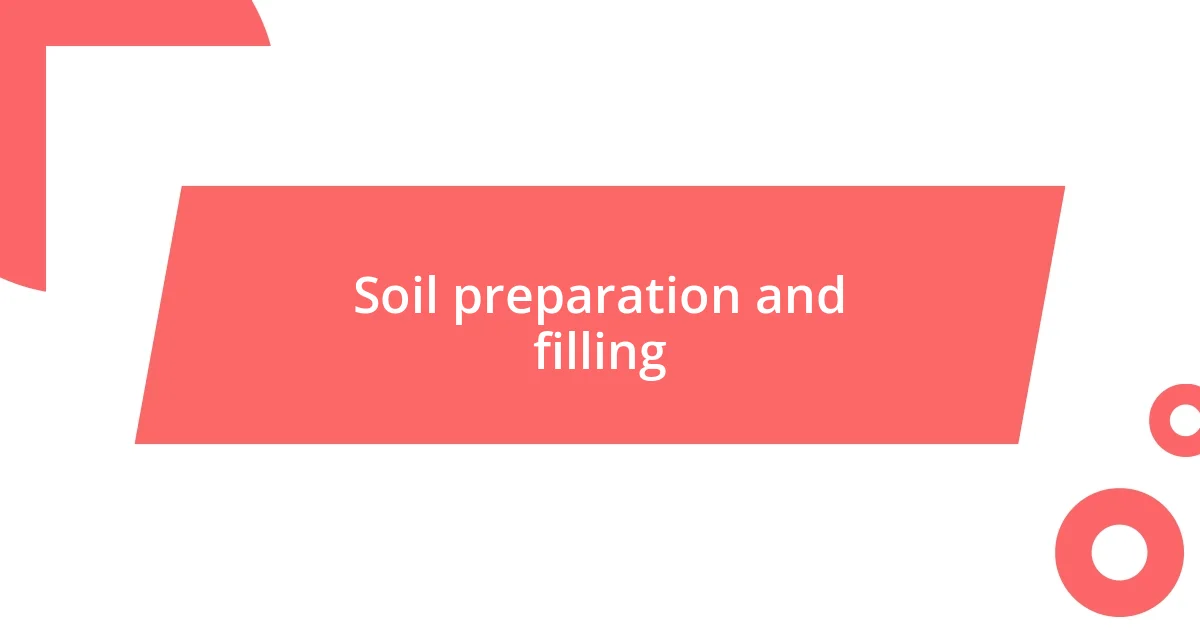Key takeaways:
- The motivation for raised gardening stems from the desire for fresh produce, physical activity, and a sustainable connection to nature.
- Choosing the right location, ensuring adequate sunlight, accessibility, and proper drainage, is crucial for a successful raised garden.
- Soil preparation with the right mix of nutrients and careful planting methods, including companion planting and intercropping, significantly enhance plant growth and garden health.

My motivation for raised gardening
One of my driving motivations for embracing raised gardening was my desire for healthier, fresh produce. I still remember the first time I bit into a ripe tomato I had grown myself. It burst with flavor, unlike anything I’d ever tasted from the grocery store. That experience left me wondering: isn’t food meant to be enjoyed at its best?
Additionally, the physical aspect of gardening played a big role in my decision. I often found myself longing for an activity that combined exercise with tranquility. Raised gardens caught my attention because they allowed me to tend to my plants without the strain of bending down constantly. There’s something incredibly satisfying about kneeling beside my garden, feeling both the soil and the serenity embracing me at the same time.
Moreover, I was inspired by the sustainability aspect of raised gardening. As I learned more about environmental impacts and soil health, the question arose: how can I contribute positively? Building a raised garden felt like a step toward nurturing the earth while also creating a space for inspiration and growth. Each time I harvest, I feel a wave of responsibility towards the ecosystem and a profound connection to nature that nurtures my soul.

Choosing the right location
Choosing the right location for your raised garden is paramount to its success. I remember the first time I set up my garden; I hastily picked a spot near the fence, only to realize it barely received any sunlight. It was a frustrating lesson. Ideally, your garden should be in a location that enjoys at least six hours of direct sunlight daily. This ensures your plants get the energy they need to thrive.
Another factor to consider is accessibility. I’ve found that having my garden close to my kitchen makes a world of difference. It’s so convenient to step outside and snip fresh herbs or vegetables for dinner. Additionally, you want to ensure it’s easy to maintain; if you have to trek far through the yard, you might find yourself skipping those essential tasks of weeding and watering.
Finally, think about the drainage of the area. When I first started, I overlooked this crucial aspect and ended up with a flooded garden after a heavy rain. A well-drained spot not only protects your plants but provides a healthier growing environment. Remember, the right location sets the stage for your raised garden’s success!
| Factor | Considerations |
|---|---|
| Sunlight | At least 6 hours of direct sunlight for optimal growth |
| Accessibility | Close to your home for easy maintenance and harvesting |
| Drainage | Choose a well-drained area to prevent waterlogging |

Selecting materials for construction
Selecting the right materials for constructing your raised garden can significantly influence its durability and aesthetics. I remember standing in my local hardware store, overwhelmed by the choices in front of me—wood, metal, concrete. Each option had its pros and cons. While treated lumber is popular for its affordability and ease of use, I quickly learned about the potential chemicals leaching into the soil. This prompted me to consider natural alternatives like cedar or redwood, which may be a bit pricier but offer longevity without compromising plant health.
Another important factor to weigh is the height of your garden bed. I began with a traditional 12-inch height and soon realized my back was sore from bending over to reach the plants. Going for a taller option can save you that discomfort, making access so much easier. Ultimately, I found that incorporating a mix of materials not only enhanced the structure but also created a unique look.
- Wood: Affordable and easy to work with; select untreated varieties for soil safety.
- Metal: Durable and modern, but can heat up quickly, affecting soil temperature.
- Concrete blocks: Very sturdy and customizable, ideal for a longer-lasting garden.
- Composite materials: Made from recycled materials; resistant to rot and splintering.
Reflecting on my journey, I realized that every choice, from the wood grain to the height of the bed, was a step toward crafting a garden that felt like an extension of myself. Each material carries a part of the story, making it not just a garden but a personal sanctuary.

Designing the raised garden layout
When it came to designing the layout of my raised garden, I realized early on that a thoughtful approach could make all the difference. I once sketched out my plans on a notepad, envisioning rows of vibrant vegetables that would flourish together. I found it crucial to consider the dimensions of each bed and the spacing between them to promote air circulation. This practical thinking not only helped with maintenance but also maximized the use of space in my backyard.
I distinctly remember the excitement of planning companion planting, where certain plants benefit one another. For instance, I paired tomatoes with basil, and watching those two thrive alongside each other felt rewarding. I can’t stress enough how important it is to visualize how each plant will grow and interact with its neighbors. It’s one thing to have a beautiful layout on paper, but it’s another to see it come alive in real life.
Lastly, I should emphasize the role of paths in your layout—something I took for granted initially. I designed narrow pathways that limited access, and eventually regretted that decision when I squeezed between beds to reach my crops. Now, I ensure my paths are wide enough for a wheelbarrow or even just a relaxing stroll. I’ve found that as much as aesthetics matter, functionality plays an equally significant role in enjoying your gardening journey.

Soil preparation and filling
When it came to soil preparation, I learned firsthand that the right mix is crucial for healthy plant growth. Initially, I simply tossed in some bagged soil, convinced it would be enough. However, my plants struggled, leaving me puzzled. That’s when I discovered that a blend of compost, topsoil, and some added nutrients makes a world of difference. The transformation in my plants was like magic; they perked up within days!
Filling the beds was surprisingly a therapeutic process for me. Imagine layering different materials, like building a cake! I started with a thick layer of cardboard at the bottom to suppress weeds, then added a rich compost mix. Watching the vibrant colors and textures come together brought me such joy and a sense of accomplishment. It felt rewarding to know that I was creating a nurturing environment for my plants.
Have you ever tested your soil? I did this one afternoon, and it opened my eyes to the importance of pH levels and nutrient balance. Simple kits, which I found online, can help you uncover secrets buried beneath the surface. After adjusting the soil based on those tests, my garden flourished like never before. It’s fascinating how these little steps can lead to such significant changes, isn’t it? Each layer of soil became a foundation, not just for my plants, but for my journey as a gardener.

Planting methods and crop selection
Choosing the right planting methods and crops for my raised garden was quite the adventure! I remember standing at the local nursery, overwhelmed by the colors and varieties of seedlings. After researching which crops thrived together, I decided on a mix of leafy greens and root vegetables. Lettuce and radishes became my go-to duo; they not only jived well with each other but also filled my beds with contrasting textures and shades. Isn’t it uplifting to see a garden bustling with life?
In my experience, direct seeding versus transplanting can be a game-changer. Early on, I went for direct sowing, which felt like a gamble because not every seed germinated as I had hoped. After some trial and error, I transitioned to starting seeds indoors and transplanting them later. The moment I placed my little seedlings into their new beds felt rewarding, especially when I watched them acclimate and flourish quickly. Have you ever felt that thrill of nurturing something from a tiny seedling to a thriving plant? It’s a small miracle every gardener should experience.
Another method that proved essential for me was intercropping. As I planted my sweet corn alongside beans and squash, I couldn’t help but feel a bit like a conductor, orchestrating a symphony of growth. The beans climbed the corn, while the squash spread out, creating a delightful ground cover. I learned that this method not only maximized space but also created a balanced ecosystem, enhancing soil health. Isn’t it incredible how nature knows just how to work together? Each day spent among my plants became more than just gardening; it became a lesson in harmony.

Maintaining and harvesting your garden
Maintaining my raised garden has become a daily ritual that I genuinely look forward to. I remember the first time I walked through my garden in the early morning, coffee in hand, noticing the subtle changes in my plants. Keeping an eye on them as they grow feels like a personal relationship; each wilted leaf or thirsty soil is a call for attention. Have you ever paused mid-task and noticed how even a small weed can change the layout of your garden? I learned to pull them out regularly, turning what once felt like a chore into a meditative practice.
When it comes to harvesting, I can’t stress enough how exciting that moment can be! I distinctly recall my first tomato harvest; the little red fruits seemed to glow in the sunshine. Carefully picking them, I felt a wave of pride and joy wash over me—this was the fruit of my labor, quite literally! I found that timing your harvest is key; it’s like waiting for just the right moment in a performance. Picking too early or too late can change the taste and texture drastically. How do you know when it’s just right? I learned to trust my instincts and research the signs of peak ripeness with visual cues and a gentle squeeze.
As seasons change, maintaining the garden also means reflecting on the past harvest to plan for the future. I developed a habit of jotting down notes after each harvesting session, noting what thrived and what didn’t. This practice adds a layer of personal growth to my gardening journey. Have you thought about how your garden can tell a story? It’s remarkable to see how each year’s experiences shape what you choose to plant next, weaving together a narrative of discovery and improvement.















